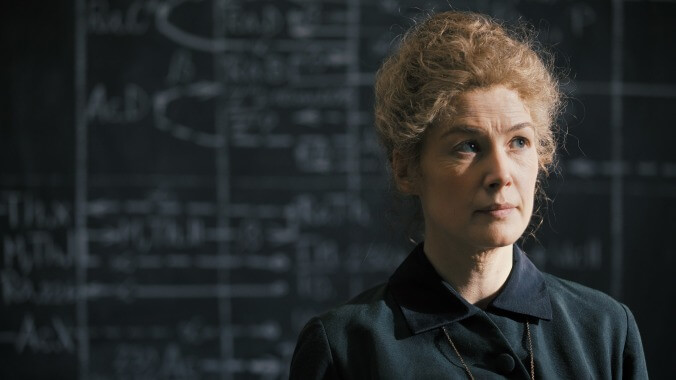There are other examples of questionable artistic intent in Radioactive, including additional egregious glimpses into the future and montages inspired by spiritualism and dance. The clichés are equally plentiful: terminal illness indicated by blood on a hankie, the cloying sight of an audience standing up and clapping slowly. The only consistent distraction from this corniness is the fact that the movie looks like an expensive commercial for perfume, in which Curie and her husband, Pierre (Sam Riley), are always found in romantic Paris backdrops and interiors. Is it Eau de Curie or Radium No. 5?
In fact, Satrapi, a graphic novelist turned director who is best known for her autobiographical animated film Persepolis, wants us to believe Curie’s life was really a love story. After an opening scene set in the 1930s, we flash back to the 1890s and the first chance meeting between Marie, who is then still known as Maria Skłodowska, and her fellow scientist Pierre. She is headstrong. He is patient. As it turns out, they are both interested in the phenomenon of radioactivity. This will lead them to spend a lot of time around radioactive elements and each other, resulting in romance, marriage, and lethal exposure to radiation. There are children, too, including Irène Curie, who like her parents, would go on to win the Nobel Prize. At one point, she abruptly turns into a young woman played by Anya Taylor-Joy.
It’s easy to imagine a stranger film (or one that lives up to Radioactive’s visual excesses) making something of these gothic proximities of romance and death and the bizarre circumstances of Pierre’s demise. But though the script, which was adapted from a book by Lauren Redniss, tells us nearly as much about Marie Curie’s sex life as her research, it mostly follows the template of lackluster science biopics along the lines of The Imitation Game, The Theory Of Everything, and The Current War. However, one must give credit where it’s due: The chemistry between Pike’s poise and Riley’s delightfully fuzzy John Hurt voice is enough to convince the viewer that they are watching a good movie, at least for roughly the first 20 minutes.
From there the troubles start, as the incoherent love story begins vying with the worst tropes of biographical drama. Most of us know, at best, two concrete things about Marie Curie: She won the Nobel Prize twice and died from the long-term effects of exposure to radiation. There is not much more to be gleaned from Radioactive. Chronologies are fudged. Events, motivations, and conflicts are invented out of whole cloth. In the interest of not wasting the reader’s time with nitpicking and fact checks, this writer will simply point out that Pierre Curie did not leave Marie behind to look after the kids while he went to Sweden to accept their shared Nobel Prize and that the life and career of Marie Curie does not, in fact, appear to have been entirely motivated by an extreme phobia of hospitals.
Of course, there’s nothing wrong with playing fast and loose with history or just making stuff up. Plenty of great movies do. The problem with films like Radioactive is that they neither fulfill the biography’s basic duty of elucidating the life and times of the subject nor offer a compelling artistic vision or drama as a substitute for the hard facts. Satrapi strains to make the movie aesthetically interesting by deploying an intermittently Space Age score, color coding, and a sequence in which Marie imagines Pierre’s coffin being carried away by glowing, Loïe Fuller-inspired figures who look like haute couture interpretations of Halloween decor. But this high-end kitsch can’t cover up another conventionally dull biopic that begins with someone looking back on their entire life and ends with a very long slideshow of onscreen text.



 Keep scrolling for more great stories from A.V. Club.
Keep scrolling for more great stories from A.V. Club.